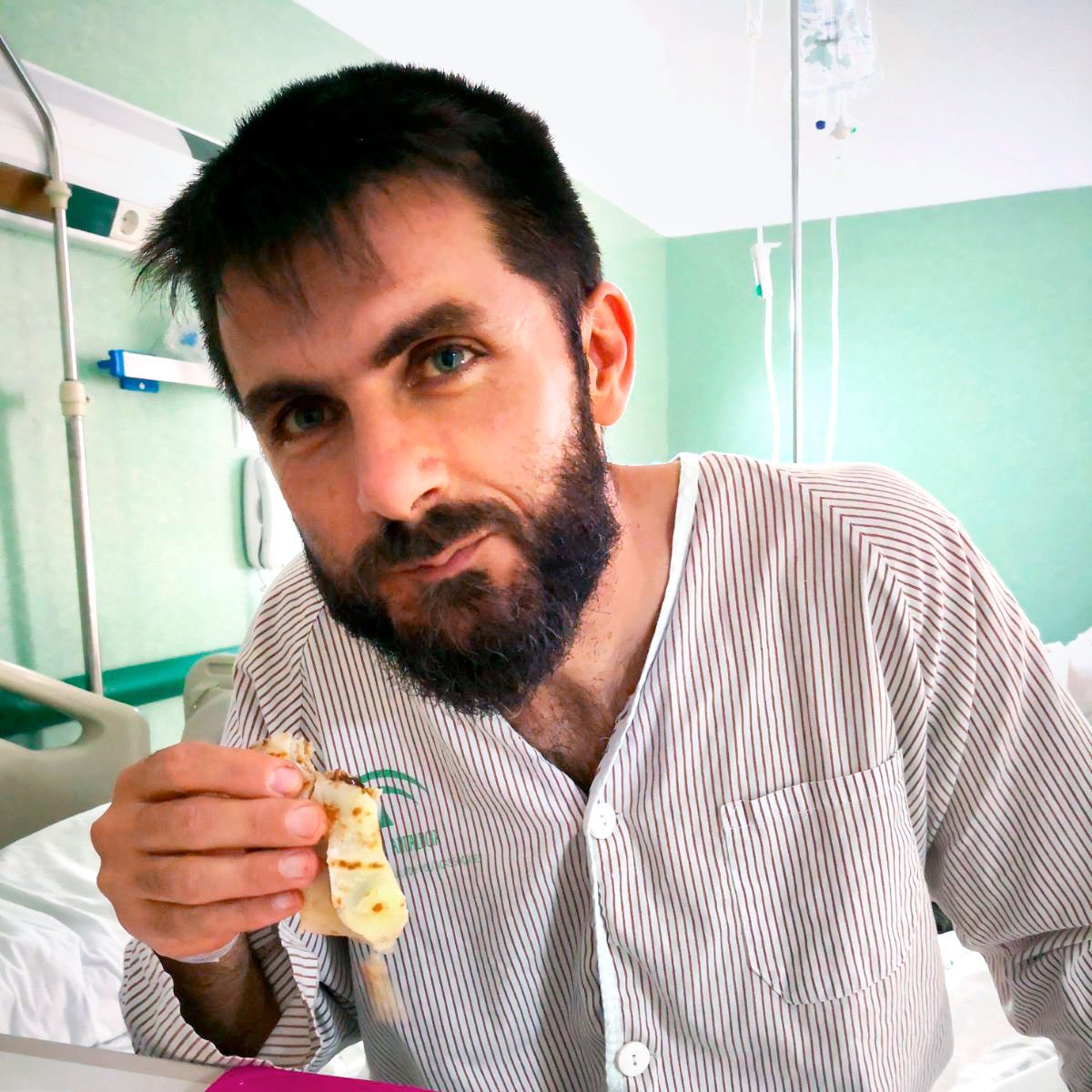
Lasse Berget, Norway
Lasse Berget was 43 years old and weighed 175 kilograms. A security guard from Filtvet, a seaside village in Norway, he had a big appetite. He could eat eight cheese and salami sandwiches for breakfast, several hamburgers for lunch and plates of pasta or pizza for supper. Steadily gaining weight since his twenties, he felt progressively more tired and suffered increasing aches and pains.
Finally, after being nearly bedridden, he asked his doctor for a checkup. A blood test showed high levels of fat in his blood and an ultrasound scan revealed non-alcoholic fatty liver disease, or NAFLD, in which fat deposits form within the organ.
When Lasse researched his diagnosis, he was scared. “I realized quickly that the disease can be deadly,” he says. If neglected, it can lead to a lethal liver-disease stage or cancer.
Nearly one in four people in Europe has NAFLD, according to a paper published in the Journal of Hepatology in September 2018. Linked to obesity and diabetes, it is a lifestyle disease born of carbohydrate overload and lack of exercise. “If you’re burning fewer calories than you’re eating, your body starts storing fat, and many people have a genetic predisposition to store it in the liver,” says Dr. Ashley Barnabas, a hepatologist at King’s College Hospital NHS Foundation Trust in London.
According to a 2018 study, Europe has the highest rates of liver disease in the world. Besides NAFLD, other contributing factors are alcohol overuse, medication overuse and infectious hepatitis—a liver inflammation caused by viruses. Overall 29 million people in the European Union have a chronic liver condition. Every year about 47,000 people in the EU die from liver cancer and across Europe 170,000 die from cirrhosis—the breakdown of the organ caused by scar tissue from long-term disease or alcohol abuse—which covers the main causes.
Unfortunately, the early stages of liver diseases produce no symptoms. Some NAFLD patients may feel tired or nauseous, but many don’t, and their condition can only be diagnosed by checking liver enzymes on a blood test, or an ultrasound or another imaging test. Currently, no public health policies in Europe prescribe an annual liver health check, so unless patients complain, doctors don’t routinely screen for liver disease.
“You can have [liver disease] for many years and not know it—often there are no symptoms until the liver breaks down,” says Dr. Tom Hemming Karlsen, PhD., at the University of Oslo who serves as secretary general for the European Association for the Study of the Liver. When that happens, your body falls apart quickly because without the liver, other organs can’t function.
People often underestimate how important this organ is. “Liver is a master regulator,” notes Dr. Rajiv Jalan, PhD., a hepatologist at University College London. It supplies bile to break down fat during digestion and stores energy, releasing it as glucose. It produces proteins involved in metabolism and blood coagulation. It acts as a “cleaning plant” which filters out toxins; and regulates the immune function, separating and removing bacteria from the bloodstream. Overall, the liver performs more than five hundred different tasks—a feat that’s hard to replicate.
That’s why medics have no replacements for failing livers. Dr. Jalan’s team is working on creating a bioartificial liver device called DIALIVE, but it’s not yet available. And while maladies such as stroke afflict people over 65, failed livers tend to kill at a younger age.
Another culprit is glucose-fructose syrup, a common sweetener found in processed foods including many cereals, snacks and juices. Unlike fruits which contain limited amounts of fructose and thus are metabolized slowly, glucose-fructose syrup “puts more sugar much more quickly into your system,” says Dr. Barnabas—so the liver regularly stores it as fat.
Lasse Berget was duly concerned about his diagnosis. While NAFLD is not immediately life threatening, over time it can progress into a disease called non-Alcoholic SteatoHepatitis or NASH, which can cause liver failure and death. Because of liver cell deterioration, NAFLD can also lead to hepatocellular carcinoma, a common liver cancer. There is no set time it takes for NAFLD to develop into NASH and further into cirrhosis, and many people with NAFLD never do develop cirrhosis. When they do, a transplant is the only cure—and the number of NASH-related transplants in Europe is going up, Professsor Karlsen says.
Pharmaceutical companies in Europe are working with researchers to develop drugs for NAFLD and expect some to arrive on the market around 2020. But the good news is that many patients don’t even need them. Unlike other organs, the liver has a remarkable ability to regenerate itself, and as long as NAFLD has not progressed into NASH, it is reversible. A multi-university study by researchers in Sweden, Finland and the United States in 2018 found that reducing carbs consumption for just two weeks reduced NAFLD significantly.
These are the signs your liver might be in trouble.

Richard Allen, England
On December 3, 2014, when his home town Stoke-on-Trent in Staffordshire, England, was settling into the Christmas mood, Richard Allen was vomiting blood. He and his wife called an ambulance. The doctors told him he had liver cirrhosis—bands of scar issue so thick his liver grew benign tumors. Cirrhosis can increase blood pressure in the portal vein that connects the liver with the intestines and other organs, creating smaller blood vessels in the stomach that can burst and cause internal bleeding.
Richard knew that alcohol was to blame. Whenever his depression struck, and the medications stopped working, the now 66-year-old retired security specialist reached for the bottle. “Every three to four weeks, I was drinking for three to four days,” he says. As liver cells try to metabolize an overload of alcohol they die out, leading to inflammation and scar tissue formation, or fibrosis, and cirrhosis.
Doctors removed two of Richard’s largest tumors but told him he would need a liver transplant. Some patients wait for a donor match for years—and die before they get it. But Richard was lucky. On October 1, 2016, he received his new liver at the Queen Elizabeth Hospital in Birmingham, after a five-hour surgery—and went home nine days later.
The prerequisite for the transplant was abstaining from alcohol for six months before surgery—to prove you were worthy of this gift of life, which otherwise could have been given to someone else. Richard was fully compliant. He gave up drinking, traced his low self-esteem issues to his childhood—and better manages his bouts of depression. “It was a form of rebirth,” he says. “I wrote a letter to the donor family thanking them for this gift.” He also began volunteering with the British Liver Trust, a charity that works to increase awareness about the skyrocketing liver disease rates in his country.
Since the 1970s, the UK’s deaths from liver disease have jumped 400 per cent, spiking nearly five-fold for those under the age of 65. This amounts to 300,000 hospital admissions and 10,000 deaths a year.
In Europe, alcohol takes a commanding seat in the list of liver offenders. Europeans drink the largest amount of alcohol in the world. “Alcohol is so blended into the identity of so many European countries,” Professor Karlsen says, “that it’s even more challenging to battle than tobacco.”
Occasional over-indulging is less damaging than regular continuous drinking because liver cells have time to regenerate. But not all heavy drinkers develop liver disease, while some people who rarely drink might, and there is no way to know who will.
Watch out for the fatty liver symptoms that could lead to disease.

Francisco Cantos Pérez, Spain
Francisco Cantos Pérez thought nothing of the nip he got from a playful little dog, but not long after he developed a fungal infection that spread over his hand. The doctor prescribed two Lamisil, a common anti-fungal medication, every 12 hours.
After ten days Francisco, an active 36-year old who lives in Malaga, Spain with his family, began feeling slow and tired. Within two weeks his urine turned dark and his stool almost white. When his skin and eyes turned yellow and he began to itch, he drove to Hospital Universitario Virgen de la Victoria.
Francisco had a high level of bilirubin, the brownish-yellow compound the liver secretes into bile, and cholesterol, which the liver also makes. The doctors said he had a reaction to his medicine—probably because the dose was twice the typically recommended amount. He stayed in hospital for two weeks, until his urine colour returned to normal. His skin took over a month to lose its yellow hue and his eyes took about four months.
Generally, such extreme reactions to approved drugs are rare, says Dr. Raul J Andrade, PhD., at the University of Malaga, who runs the European liver toxicity registry. (Liver injury from Lamisil occurs once in 50,000 to 120,000 cases.) Medications that produce liver-related side effects during trials never make it to market. Yet people who show signs of liver weakness on pre-screening tests aren’t selected for new drug trials. “So, when a drug is on the market, the companies do not know how it will affect those with liver disease,” Dr. Andrade says.
Dosage plays a major role. Even common over-the-counter medications, when taken in excess of the recommended dose over a long period of time, can cause liver injury, failure and death. One of them is paracetamol, also known as acetaminophen, Tylenol and Panadol—a pain-relieving and fever-reducing drug. The recommended adult dose is one or two 500mg tablets up to four times in 24 hours, with four to six hours in between doses and without exceeding four grams a day. When exceeded, paracetamol sends nearly 100,000 people a year to hospital in the UK alone and about 150 die. “Paracetamol is the most common cause of acute liver failure in the UK,” says Dr. Jalan.
There are no accurate statistics Europe-wide for paracetamol-related deaths, but Professor Karlsen says that there are more cases in the northern European countries than in the southern ones.Even a recommended amount of paracetamol can be dangerous combined with other substances.
When taken to clear a hangover after heavy drinking, a regular paracetamol dose can overload an already stressed-out liver and cause liver injury. Most paracetamol victims are younger people who either ignored the dosage labels or combined it with alcohol, steroids or street drugs.
Learn to spot the signs of liver cancer.

Surviving the Epidemic
Viruses destroy the liver by causing inflammatory disease, such as hepatitis types A to E. The D type only affects those already with hepatitis B, and E is a recently discovered virus found primarily in developing countries, where sanitation is poor and access to clean water limited. There are medicines that efficiently treat the B type and recently the C type as well. The treatment for A and E usually amounts to controlling the patients’ symptoms while the liver gets a chance to recover.
Most people in the western world are vaccinated against hepatitis A and B, but for those travelling into areas where the disease is endemic, getting a booster shot is a good idea.
When a liver fails, patients suffer a slew of symptoms, so doctors place them on life support to buy the liver time to regenerate—or if all fails, request a transplant. “The sickest patient in the hospital is a patient with acute liver failure,” Dr. Jalan says—but if the liver recovers, “they can recover spontaneously by themselves.”
That is true of NAFLD—and Lasse Berget is a prime example. Two days after his diagnosis he changed his lifestyle. He began walking and eventually jogging and climbing hills. He changed his diet. “I ate normal healthy food, but much less,” he says. Three months later a medical check found that his liver fat was disappearing. “Today it’s completely gone,” says Lasse, who now weighs 95 kilograms, runs three to four times a week, and does a longer run of 12-to-20 kilometres weekly, and works as a health and lifestyle consultant. “My life has changed completely. I got my health and my joy back.”
Unlike Lasse Berget, other patients may never know their liver condition—because as yet there are no centralized screening polices. While experts are working to institute them, patients should follow Lasse’s example and ask their doctors for a liver enzymes test and an ultrasound scan. The liver regulates so many things in the body, it deserves your attention, Professor Karlsen says. “If you take good care of your liver, your liver will take good care of you.”
Change the way you live by reading these new health studies.